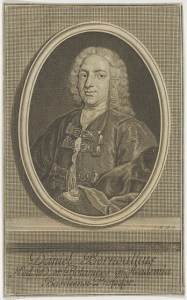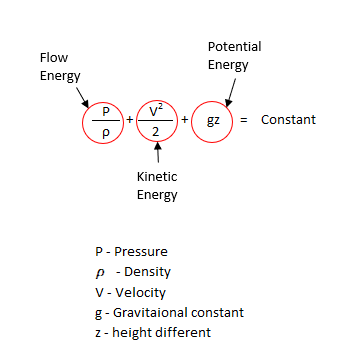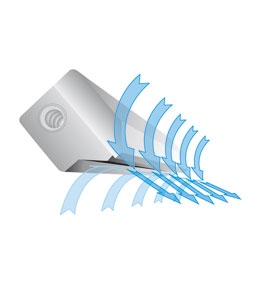
Whenever there is a discussion about fluid dynamics, Bernoulli’s equation generally comes up. This equation is unique as it relates flow energy with kinetic energy and potential energy. The formula was mainly linked to non-compressible fluids, but under certain conditions, it can be significant for gas flows as well. My colleague, Tyler Daniel, wrote a blog about the life of Daniel Bernoulli (you can read it HERE). I would like to discuss how he developed the Bernoulli’s equation and how EXAIR uses it to maximize efficiency within your compressed air system.
In 1723, at the age of 23, Daniel moved to Venice, Italy to learn medicine. But, in his heart, he was devoted to mathematics. He started to do some experiments with fluid mechanics where he would measure water flow out of a tank. In his trials, he noticed that when the height of the water in the tank was higher, the water would flow out faster. This relationship between pressure as compared to flow and velocity came to be known as Bernoulli’s principle. “In fluid dynamics, Bernoulli’s principle states that an increase in the speed of fluid occurs simultaneously with a decrease in static pressure or a decrease in the fluids potential energy”1. Thus, the beginning of Bernoulli’s equation.
Bernoulli realized that the sum of kinetic energy, potential energy, and flow energy is a constant during steady flow. He wrote the equation like this:
Equation 1:

Not to get too technical, but you can see the relationship between the velocity squared and the pressure from the equation above. Being that this relationship is a constant along the streamline; when the velocity increases; the pressure has to come down. An example of this is an airplane wing. When the air velocity increases over the top of the wing, the pressure becomes less. Thus, lift is created and the airplane flies.
With equations, there may be limitations. For Bernoulli’s equation, we have to keep in mind that it was initially developed for liquids. And in fluid dynamics, gas like air is also considered to be a fluid. So, if compressed air is within these guidelines, we can relate to the Bernoulli’s principle.
- Steady Flow: Since the values are measured along a streamline, we have to make sure that the flow is steady. Reynold’s number is a value to decide laminar and turbulent flow. Laminar flows give smooth velocity lines to make measurements.
- Negligible viscous effects: As fluid moves through tubes and pipes, the walls will have friction or a resistance to flow. The surface finish has to be smooth enough; so that, the viscous effects is very small.
- No Shafts or blades: Things like fan blades, pumps, and turbines will add energy to the fluid. This will cause turbulent flows and disruptions along the velocity streamline. In order to measure energy points for Bernoulli’s equation, it has to be distant from the machine.
- Compressible Flows: With non-compressible fluids, the density is constant. With compressed air, the density changes with pressure and temperature. But, as long as the velocity is below Mach 0.3, the density difference is relatively low and can be used.
- Heat Transfer: The ideal gas law shows that temperature will affect the gas density. Since the temperature is measured in absolute conditions, a significant temperature change in heat or cold will be needed to affect the density.
- Flow along a streamline: Things like rotational flows or vortices as seen inside Vortex Tubes create an issue in finding an area of measurement within a particle stream of fluid.

Since we know the criteria to apply Bernoulli’s equation with compressed air, let’s look at an EXAIR Super Air Knife. Blowing compressed air to cool, clean, and dry, EXAIR can do it very efficiently as we use the Bernoulli’s principle to entrain the surrounding air. Following the guidelines above, the Super Air Knife has laminar flow, no viscous effects, no blades or shafts, velocities below Mach 0.3, and linear flow streams. Remember from the equation above, as the velocity increases, the pressure has to decrease. Since high-velocity air exits the opening of a Super Air Knife, a low-pressure area will be created at the exit. We engineer the Super Air Knife to maximize this phenomenon to give an amplification ratio of 40:1. So, for every 1 part of compressed air, the Super Air Knife will bring into the air streamline 40 parts of ambient “free” air. This makes the Super Air Knife one of the most efficient blowing devices on the market. What does that mean for you? It will save you much money by using less compressed air in your pneumatic application.
We use this same principle for other products like the Air Amplifiers, Air Nozzles, and Gen4 Static Eliminators. Daniel Bernoulli was able to find a relationship between velocities and pressures, and EXAIR was able to utilize this to create efficient, safe, and effective compressed air products. To find out how you can use this advantage to save compressed air in your processes, you can contact an Application Engineer at EXAIR. We will be happy to help you.
John Ball
Application Engineer
Email: johnball@exair.com
Twitter: @EXAIR_jb
- Wikipedia https://en.wikipedia.org/wiki/Bernoulli%27s_principle